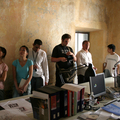Massimiliano Fuksas
— interview with Massimiliano Fuksas
About
Massimilano Fuksas is one of Italy's most renowned architects, and has recently returned to Rome after designing buildings in Paris for twenty years. Fuksas has designed the Emporio Armani flagship store in Hong Kong, the Eindhoven mall complex in The Netherlands, and construction is underway on his new Congress Center in Rome's EUR. The Congress Center competition, awarded to Fuksas in 2000, prompted his return to Rome and was the catalyst in the awakening of contemporary architecture in Rome after over a decade of no new urban development. Fuksas has three offices: Rome, Paris, and Frankfurt, and maintains complete creative control over all projects in all offices. His lack of a distinct architectural style and ability to create an entire building out of a quick sketch or a vision is what makes him so unique, respected, and difficult to pin down.
Interview Ideas
- The State of Rome: An architectural and cultural rebirth, human-centered developments leading to a more social Rome
- The Issue of Suburbs: Designing for the area between the suburbs and the city center to link the two and connect the town (specifically in Rome with it's many suburbs)
- Human-Centered Architecture: The importance of social concern/awareness in architecture, designing massive projects at a human scale through considering user needs at every step
- The Evolution of Cities: Modernizing cities to create citizen-friendly areas; to help cities evolve properly
- European Cultural Evolution: Europe's need to accept multiple cultures and adapt properly to evolve culturally.
Video/Key Quotes
- The Resurgence of Rome

- The State of Italy

- The Formation of a Town

- The Suburban Crisis

- Fixing the Suburbs

- The Rise of China

- Balancing Global Ecology

- Global Relations With China

- Giving Life to Structures

What We Learned
After interviewing Fuksas, we saw the necessity of an architect to be socially and culturally aware of global issues. Fuksas helped add context to the large problem of fixing the suburbs, using the Roman suburb of Saxa Rubra as a clear example of an area that needs improvement. Since this was only our third interview, some of the 'big' questions were still forming, and the group hadn't perfected the interview strategy yet. Fuksas, however, had no problem opening up to us, confirming our speculation of all the 'bubbling up' that is currently occurring in Rome (due to, in his words, "young architects that are crazy like me"). Fuksas' acute knowledge and precise assessments of European, North American, and Asian culture was at first a bit overwhelming, but helped us to understand different cultures of the world from an Italian perspective.
We began to see how architecture is being used to improve cities, and the effects it can have. Fuksas' attention to designing for humans is apparent in many of his projects, and he explained how his Eindhoven mall project completely changed the town, creating a social hub where the urban space is more important than the commercial stores in the mall. What we also began understanding, after only 3 interviews, was that each architect and studio has their own distinct creative style. Where Labics and IaN+ were more team oriented and relied heavily on technology to communicate, M Fuksas Arch is completely led by Fuksas himself, who creates the building concepts, oversees every iteration of every model, and prefers to not use software when designing. Although at first it seemed that perhaps Fuksas just didn't like high-tech methods of designing, it soon became apparent from the sheer amount of physical models in his studio, that he prefers them as both reminders of past projects and to show the history and depth of his company. Fuksas' use of paintings and sketches to explain his concepts, and often these rough drawings look quite similar to the final form. Fuksas himself uses an interesting "20 minute brainstorming" exercise, which is based on his idea that "more time is less time". His idea of extreme rapid prototyping and 'capturing the idea' quickly was an idea that stuck with us throughout our study in Italy.
